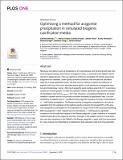Files in this item
Optimising a method for aragonite precipitation in simulated biogenic calcification media
Item metadata
| dc.contributor.author | Kellock, Celeste | |
| dc.contributor.author | Castillo Alvarez, Maria Cristina | |
| dc.contributor.author | Finch, Adrian A. | |
| dc.contributor.author | Penkman, Kirsty | |
| dc.contributor.author | Kröger, Roland | |
| dc.contributor.author | Clog, Matthieu | |
| dc.contributor.author | Allison, Nicola | |
| dc.date.accessioned | 2022-12-14T17:30:08Z | |
| dc.date.available | 2022-12-14T17:30:08Z | |
| dc.date.issued | 2022-12-02 | |
| dc.identifier | 282304217 | |
| dc.identifier | 9b571007-ac6d-4eae-91a0-94bda8a3a8c7 | |
| dc.identifier | 85143380026 | |
| dc.identifier | 000925056500010 | |
| dc.identifier.citation | Kellock , C , Castillo Alvarez , M C , Finch , A A , Penkman , K , Kröger , R , Clog , M & Allison , N 2022 , ' Optimising a method for aragonite precipitation in simulated biogenic calcification media ' , PLoS ONE , vol. 17 , no. 20 , e0278627 . https://doi.org/10.1371/journal.pone.0278627 | en |
| dc.identifier.issn | 1932-6203 | |
| dc.identifier.other | ORCID: /0000-0003-3720-1917/work/124489947 | |
| dc.identifier.other | ORCID: /0000-0002-3689-1517/work/124490017 | |
| dc.identifier.uri | https://hdl.handle.net/10023/26592 | |
| dc.description | Funding: This work was supported by the Leverhulme Trust (Research project grant 2015-268 to NA, RK, and KP) and the UK Natural Environment Research Council (NE/S001417/1) to NA, KP, RK, MC and AF. The Raman Microscope is supported by the EPSRC (Light Element Analysis Facility Grant EP/T019298/1 and Strategic Equipment Resource Grant EP/R023751/1). | en |
| dc.description.abstract | Resolving how factors such as temperature, pH, biomolecules and mineral growth rate influence the geochemistry and structure of biogenic CaCO3, is essential to the effective development of palaeoproxies. Here we optimise a method to precipitate the CaCO3 polymorph aragonite from seawater, under tightly controlled conditions that simulate the saturation state (Ω) of coral calcification fluids. We then use the method to explore the influence of aspartic acid (one of the most abundant amino acids in coral skeletons) on aragonite structure and morphology. Using ≥200 mg of aragonite seed (surface area 0.84 m2), to provide a surface for mineral growth, in a 330 mL seawater volume, generates reproducible estimates of precipitation rate over Ωaragonite = 6.9-19.2. However, unseeded precipitations are highly variable in duration and do not provide consistent estimates of precipitation rate. Low concentrations of aspartic acid (1-10 µM) promote aragonite formation, but high concentrations (≥ 1 mM) inhibit precipitation. The Raman spectra of aragonite precipitated in vitro can be separated from the signature of the starting seed by ensuring that at least 60% of the analysed aragonite is precipitated in vitro (equivalent to using a seed of 200 mg and precipitating 300 mg aragonite in vitro). Aspartic acid concentrations ≥ 1mM caused a significant increase in the full width half maxima of the Raman aragonite v1 peak, reflective of increased rotational disorder in the aragonite structure. Changes in the organic content of coral skeletons can drive variations in the FWHM of the Raman aragonite ν1 peak, and if not accounted for, may confuse the interpretation of calcification fluid saturation state from this parameter. | |
| dc.format.extent | 18 | |
| dc.format.extent | 2179044 | |
| dc.language.iso | eng | |
| dc.relation.ispartof | PLoS ONE | en |
| dc.subject | QL Zoology | en |
| dc.subject | QD Chemistry | en |
| dc.subject | DAS | en |
| dc.subject | MCC | en |
| dc.subject.lcc | QL | en |
| dc.subject.lcc | QD | en |
| dc.title | Optimising a method for aragonite precipitation in simulated biogenic calcification media | en |
| dc.type | Journal article | en |
| dc.contributor.sponsor | The Leverhulme Trust | en |
| dc.contributor.sponsor | NERC | en |
| dc.contributor.sponsor | EPSRC | en |
| dc.contributor.sponsor | EPSRC | en |
| dc.contributor.institution | University of St Andrews. Centre for Energy Ethics | en |
| dc.contributor.institution | University of St Andrews. School of Earth & Environmental Sciences | en |
| dc.contributor.institution | University of St Andrews. Scottish Oceans Institute | en |
| dc.contributor.institution | University of St Andrews. St Andrews Isotope Geochemistry | en |
| dc.contributor.institution | University of St Andrews. Marine Alliance for Science & Technology Scotland | en |
| dc.identifier.doi | https://doi.org/10.1371/journal.pone.0278627 | |
| dc.description.status | Peer reviewed | en |
| dc.identifier.grantnumber | ORPG-3815 | en |
| dc.identifier.grantnumber | NE/S001417/1 | en |
| dc.identifier.grantnumber | EP/T019298/1 | en |
| dc.identifier.grantnumber | EP/R023751/1 | en |
This item appears in the following Collection(s)
Items in the St Andrews Research Repository are protected by copyright, with all rights reserved, unless otherwise indicated.

